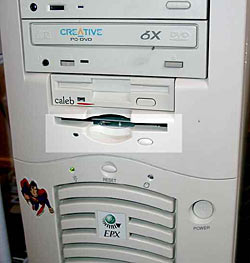
The answer!
Publication date: 16-May-2003.Last modified 03-Dec-2011.
Here's the answer to Dean's question at the end of this column. I'll let Dean say it, since I couldn't figure it out:
I tried everything I could think of to solve the floppy problem - swapping floppy drives, isolating ground, remounting the floppies, swapping floppy cables, Feng Shui, and so on, all to no avail.
Well, for no particular reason, the solution came to me the other day.
It was simply mechanical interference.
Refer to the highlighted area in the attached image...
...and you'll see that these cases are the fancy types that have a bezel covering the floppy drive. It requires you to remove the floppy's own bezel, but that's okay, and the Antec bezel clips over the front and makes everything look swell.
Close inspection of that "bezel/floppy relationship" showed me that the eject button on the Antec bezel was in contact with the floppy's own eject button, just enough to semi-eject the floppy by a few millimeters.
It wasn't noticeable to the eye, but it was enough to signal Windows that no disk was installed.
I slid the floppy drive back an eighth of an inch, and both systems are working!
In a word:
Sheesh.
My apologies to any readers who were expecting an answer involving an electrocuted hamster, or something.
Note that the versions of the SX630 and SX835 that Antec are currently selling don't have this bezel any more; they've got a couple of ordinary plastic 3.5 inch faceplates below the 5.25 inch ones, instead of one plate and one bezel-thing.
This might be because of other customers who discovered the same problem Dean did, and then, perhaps, expressing their views regarding Antec's design aesthetic.


